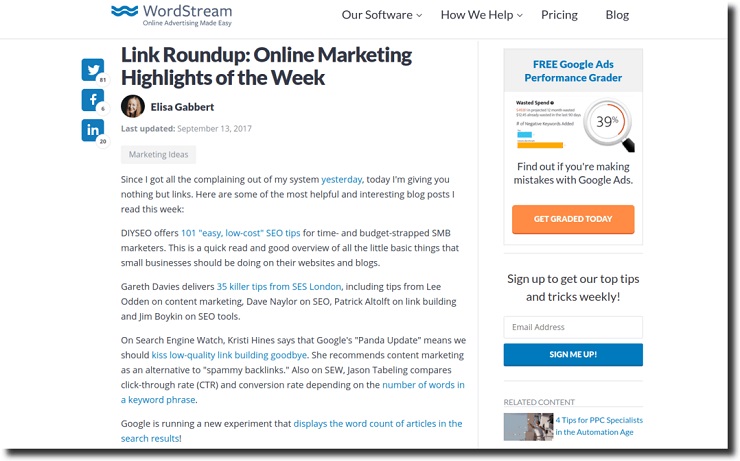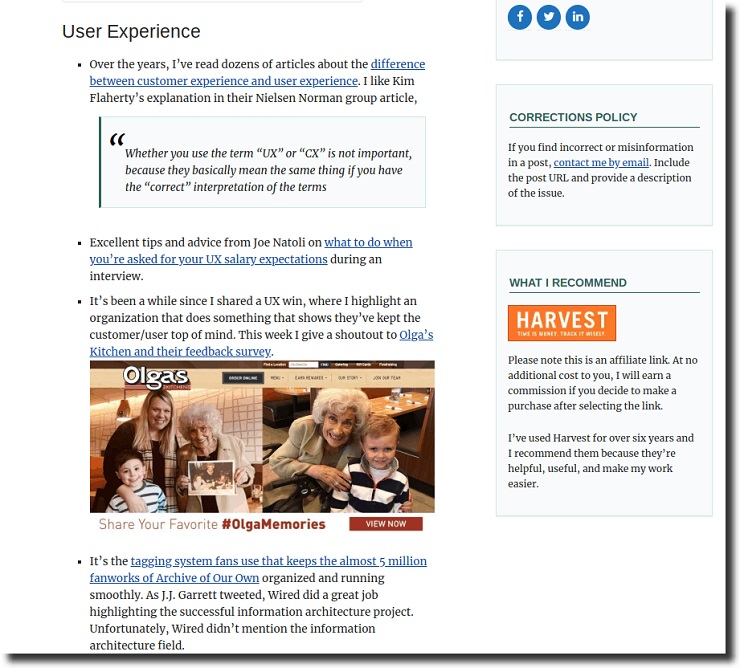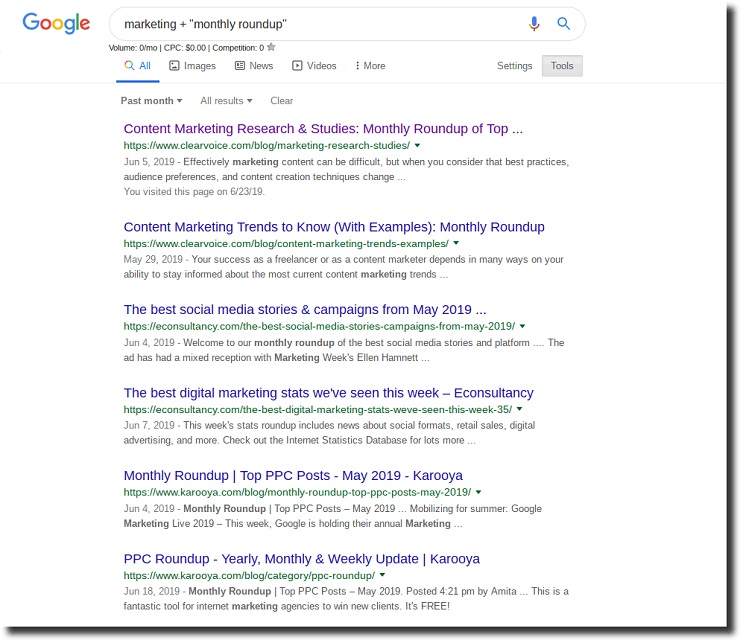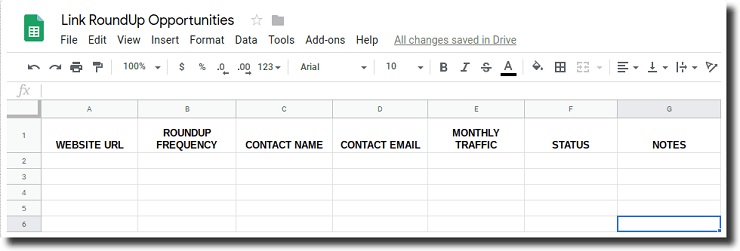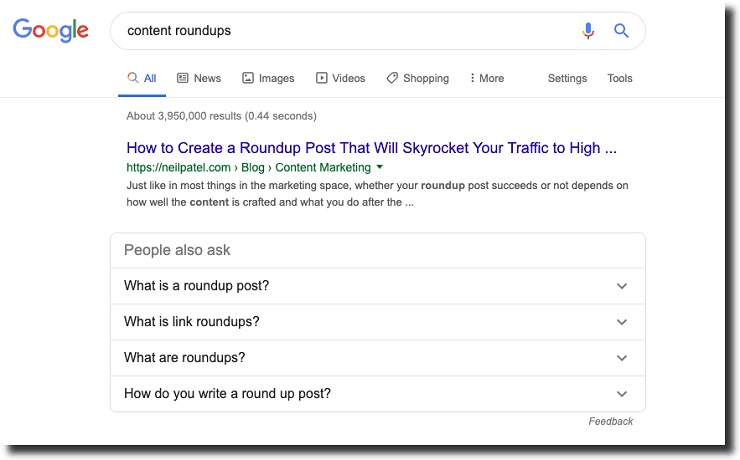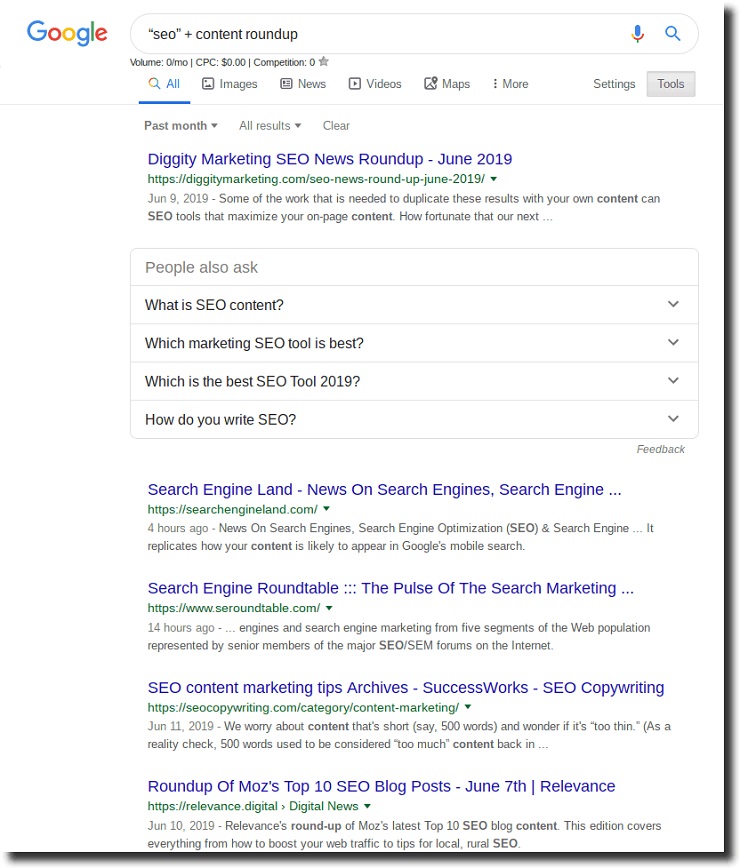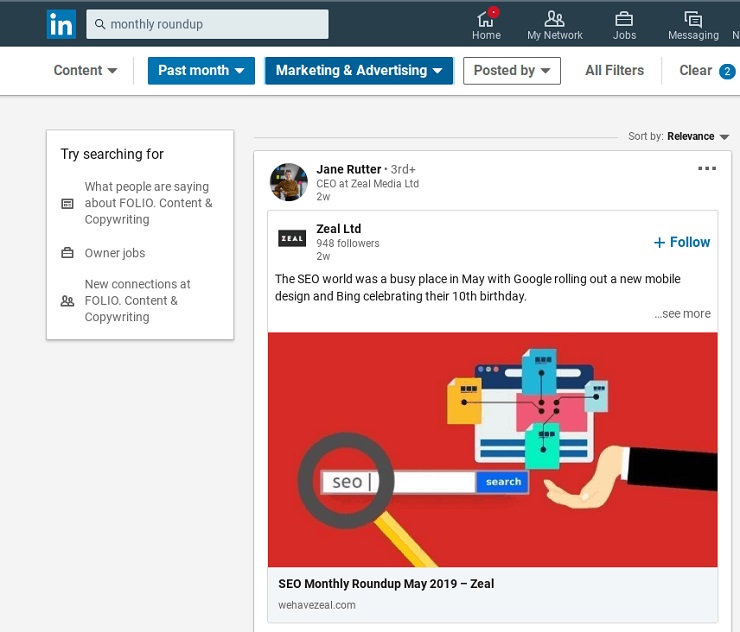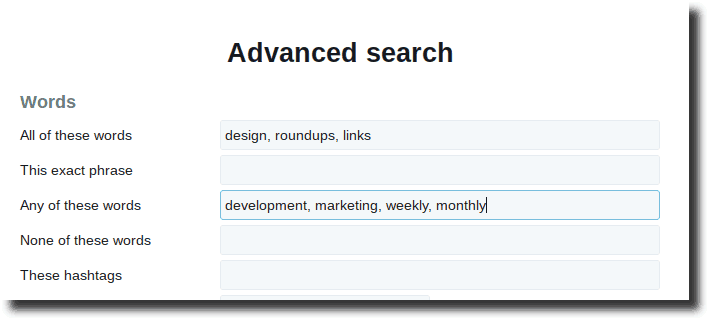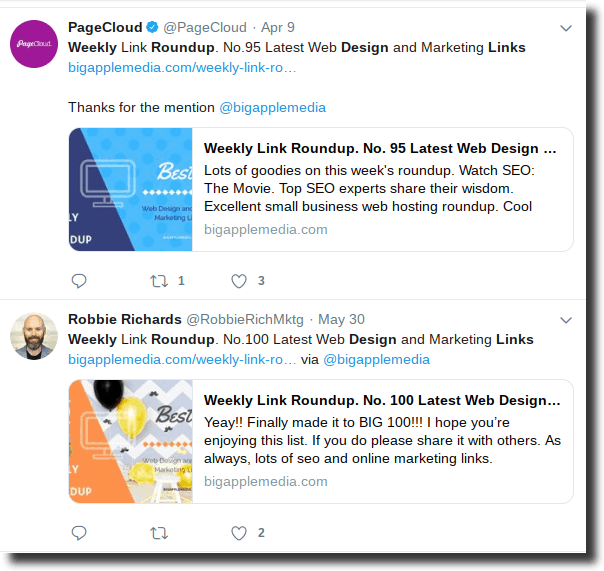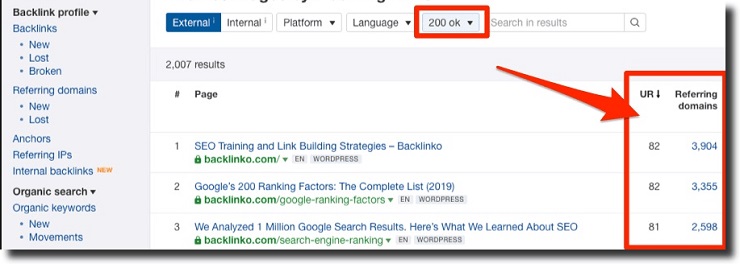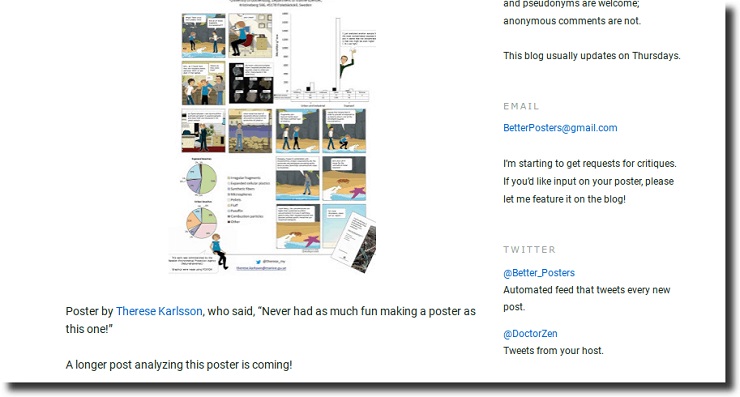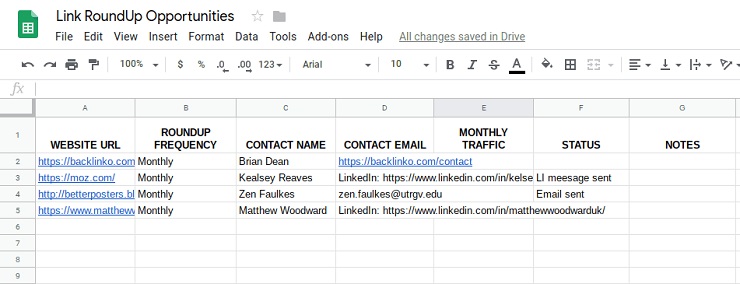Getting your content featured or linked on authoritative sites is an important component of any content marketing strategy. One of the easiest ways to do that is through content roundups, a link-building strategy that also drives traffic to your site and positions you as a thought leader.
That all sounds great, but what exactly are content roundups?
Content roundups, sometimes called link roundups, are monthly or weekly blog posts of curated industry content, typically featured on authority sites, high-profile blogs, or industry news sites.
Editors on these sites regularly publish summaries of the best posts and articles that appeared elsewhere on the web. Good roundups will summarize 10 to 12 pieces from the previous month or week, linking back to the original post. For editors on these sites, it’s a great way of padding content calendars without spending too much time or money on original content.
For the rest of us, content roundups are a great opportunity to earn relevant backlinks that boost rankings, and result in qualified traffic. All we need to do to make it into these roundups is consistently publish great content, and make sure that the right people are seeing it.
Piece of cake, right?! With a little elbow grease and strategic outreach, this is actually very doable, and the results are well worth it.
EXCLUSIVE FREE TRAINING: Successful Founders Teach You How to Start and Grow an Online Business
Here’s an example of a content link roundup from WordStream, an internet marketing site:
Here’s another example, this one from a design and development site. Although this is a smaller site, I particularly like the effort that went into creating the summaries. They are short, but well written and valuable, as opposed to being just a clump of random links thrown together.
Paul Teitelman, of Teitelman SEO Consulting, says you shouldn’t dismiss content roundups done by smaller, less authoritative sites, either, especially if they are in your niche and done regularly. According to him, “these types of roundups are great for networking and will, eventually, result in extra opportunities, such as content collaborations, guest posting gigs, and more.”
Content roundups are a regular thing in marketing, web development, design, SaaS, and similar industries (check the publishing dates on the image below), but other industries use them, too. Finance, health, nutrition, and fashion are just some that come to mind.
Sometimes, though, you will have to dig a bit deeper or settle for something niche-adjacent. The effort becomes worth it the first time you manage to land several good backlinks for a day’s worth of outreach.
For example, here are six websites that do content roundups (that are not in the marketing niche):
- BetterPosters does regular roundups about topics surrounding scientific posts.
- The New York Power Authority has an energy and tech content roundup.
- TechData has a monthly technology content roundup.
- Maryland Risk Management Education curates legal and HR news from the state.
- Tread Lightly/Retire Early publishes a women-centric personal finance roundup.
- Ben Greenfield finds popular fitness and nutrition posts to share with his readers.
Getting mentioned in authoritative content roundups depends on two things—the quality of your content, and your outreach and pitching skills.
I use this three-step process to land several highly valuable backlinks every month:
- Make sure your content is roundup-worthy
- Find websites that regularly publish content roundups
- Create the perfect pitch for your content
3 Elements of Roundup-Worthy Content
Personally, I enjoy content roundups because my busy schedule doesn’t allow me to follow all the industry news as diligently as I would like. A good link roundup allows me to scan the summaries, and provides easy access to those original pieces that I want to know more about.
On the other hand, if a roundup is uninteresting, unoriginal, or poorly curated, I (and hundreds of others) won’t be coming back to it.
Editors know that the success of these posts are tied to the quality of the links, which is why they are very selective about what (and who) they feature.
Here are some of the boxes your content needs to tick to be roundup-worthy:
- It’s valuable and actionable – Your homepage and services pages don’t qualify. Most content roundups link ultimate guides, how-tos, and comprehensive list style posts—you know, content that’s insanely valuable.
- It contains original research and data – Lack of proprietary data is not an immediate deal-breaker but most editors prefer to link to something that hasn’t been rehashed a hundred times already.
- It’s been recently published – There’s no point in pitching a guide you published a year ago. It’s stale and obsolete. Work on a thorough update before attempting a pitch.
How to Find Content Roundup Opportunities
Finding quality content roundups to pitch is not as easy as you might think. There will be some very obvious sites in your niche that you’ll want to reach out to, but not too many. To find all the opportunities, you’ll need to get creative with your search.
Before you start on this, do some groundwork.
Because you’ll be dealing with a lot of potential sites, you’ll want to create a simple spreadsheet that will help you track your progress. I like to record website URL, roundup posting frequency, contact name and email address, monthly website traffic, and status.
Here’s an example of the spreadsheet I use:
I strongly suggest using something similar to track your progress.
When you find a potential website you want to pitch, record the URL and the contact information, and move on to the next one. Ideally, you will want to swap any generic email with the author’s personal one (I’ll cover that in a bit), but it’s good to have something there at this point.
Now it’s time to start looking for roundup opportunities. I use three different methods to make sure that I’ve collected as many relevant contacts as I can:
- Google search operators
- LinkedIn and Twitter search
- Manual website search
Here are some hacksfor each of them that speed up the process and return more qualified results.
How to Use Google Search Operators
Searching for content roundups on Google can be frustrating if you don’t know what you’re doing. Just typing the phrase into the search box will pull in a lot of results about “how to create content roundups” without a single actual roundup in sight. You will get similar results even if you type in content roundups + industry.
Enter Google advanced search operators.
These operators allow you to narrow your search by telling Google which terms need to appear together and at what location on the site or in the URL. For example, typing in “seo + intitle:content roundup” gets us these results:
Since not all content roundups are called roundups, you’re going to have to get a little creative when searching for them. Here are some queries that might get you the results that you need:
- “Keyword” + “best posts of the month”
- “Keyword” + “favorite posts of the week”
- “Keyword” + “curated weekly posts”
- “Keyword” + “top posts of the week”
- “Keyword” + “link roundup”
- “Keyword” + “weekly roundup”
- “Keyword” + inurl:roundup”
- “Keyword” + intitle:roundup
- “Keyword” + “best blogs of the month”
- “Keyword” + “best blogs of the week”
Searching through all of these variations will give you a lot of different results. Just remember to limit the search to “past month”. Your goal is to pitch the sites that are publishing roundup links consistently in the last few months, and this will help narrow the search.
LinkedIn and Twitter Advanced Search
Once you’re done with Google, it’s time to focus on social networks. Twitter is by far the most useful network when it comes to content roundups, but I like to look at LinkedIn as well.
Here’s why.
Even though LinkedIn content search options leave much to be desired, most content roundups that you do find will be shared by their authors. This makes pitching a lot easier, which is why I like to look at LinkedIn even while mentally preparing myself for slim pickings.
Here an example of a good LinkedIn find (of course, it’s related to SEO):
Don’t forget to choose the author’s industry, as well as limit the range to last 30 days. After that, just try different keyword combinations until you find something of interest that you will record in your spreadsheet.
Twitter, luckily, makes search much easier. Also, since it’s still used by most companies to send out short, automated tidbits out into the world, a Twitter search for content roundups from any industry yields at least a couple of results every month.
Twitter’s advanced options allow you to play with your search. You can cast a wide net, or choose to focus on exact phrases to get more specific results.
Again, don’t forget to try different keyword variations. As with other searches, you will want to limit your Twitter search to the last 30 days to save time, and to increase the chances of finding active link roundup posts.
Manually Search Websites You Want a Backlink From
Although the search operators I discussed earlier are a great help when finding content roundups, you still might miss those with non-standard names.
For example, a roundup that’s titled “Fetching Friday” won’t show up on your radar. Neither will roundups with names such as “Industry Blast” or “The Buzz of the Week.”
Sometimes, highly authoritative sites will give their content roundups whimsical names. To avoid missing out on a great backlink, I suggest creating a list of high-Domain Authority sites in your industry, and manually searching them.
Additionally, you can go to top sites in your vertical to identify content that has a lot of backlinks. Run that content through a backlink tool (I prefer Ahrefs) and scan for URLs that look like they might be content roundup—they will contain words such as weekly, monthly, best posts, collection, content blast, and similar.
Once you find a match, record the data into your spreadsheet, and move on with the next piece of authority content you’ve identified.
EXCLUSIVE FREE TRAINING: Successful Founders Teach You How to Start and Grow an Online Business
Here’s an example of a content link roundup from WordStream, an internet marketing site:
Pitch Your Content Like a Pro
The first thing you want to do is add as much relevant information to your spreadsheet as possible. Sending your pitch through the website’s contact form rarely gets you a response. Ideally, you want the author to read your pitch because it’s targeted at them.
Here’s an example from the BetterPoster roundup mentioned above. The email listed on there is [email protected] but let’s see if we can find something better.
There’s a bit on the site about it being part of a different web property, DoctorZen.net. When I looked there, I found a faculty page of one Zen Faulkes, a professor of biology at the University of Texas Rio Grande Valley. This page also lists his academic email, along with alternative contact information.
Finding out who the author of a roundup is will generally be easier than this.
Just check the author box and see if it’s clickable. Often, it will lead you to a page that has contact information on it.
If it doesn’t (as is the case with Matthew here), a simple Facebook or a LinkedIn search will get you the information that you need.
In the end, your spreadsheet will look something like this:
Now is the time to start sending your content roundup pitches.
Let me be clear here. I still haven’t come across a bulletproof pitching formula. Whatever you write, you will never get a 100% response rate. This is tough, and you’ll need a thick skin.
What I will tell you is that all great pitches have one thing in common—they offer great value.
If what you’re pitching is boring, unactionable, and unoriginal, you won’t get much traction. If it’s awesome content that people will get a lot of use from, then you might be onto something.
Keep the following in mind to increase your chances of getting a response when pitching content roundup authors:
- Address the recipient by name whenever possible.
- Demonstrate that you are familiar with their content.
- Keep your pitch under 200 words.
- Ask what you want clearly and succinctly.
- Tell them why it’s valuable to them.
- Demonstrate the willingness to do promo work.
Here’s an example of a good pitch that clearly follows the advice above. Notice how the pitch doesn’t overtly ask for anything. It also leads with value, offering a resource without the recipient having to ask for it. That bit about social shares in the PS is also worthy of a mention, as it signals that the editor can always rely on you to send good traffic their way.
Get Featured in Content Roundups to Get Powerful Backlinks, Qualified Traffic, and Authority Boost
Getting featured in a popular link roundup is a great way to squeeze some extra juice from those posts that you put so much work into.
While getting a good backlink is great, don’t forget that it’s not all about your link profile. There’s value in smaller content roundups, too, as they get your content in front of people you can’t reach on your own.
Whenever you appear in a content roundup, you can expect a steady trickle of qualified traffic to your posts. Those people now know about you and are more likely to search out your content in the future. Also, they know you’re good at what you do—no one would link to you (or even mention your content) if you weren’t, right?
I think these are reasons enough why content roundups should have a place in your list of favorite link-building strategies from now on, don’t you?
What content roundups do you love? Any questions on getting featured in one? Leave a comment below!
EXCLUSIVE FREE TRAINING: Successful Founders Teach You How to Start and Grow an Online Business
Here’s an example of a content link roundup from WordStream, an internet marketing site:

